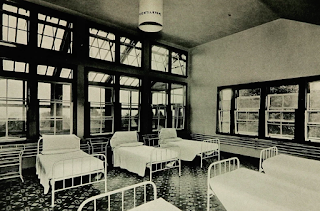The State Lunatic Hospital at Danvers was opened in Danvers, Massachusetts on May 1st, 1878. The design of the building did follow the Kirkbride plan. The site of the building was chosen for its, "beauty, privacy, view, and farming potential." According to the Kirkbride plan, the fresh air and pleasant location would contribute toward the patients' wellbeing.
 |
| Aerial view of the hospital in 2002. Retrieved from http://www.danvers-state-ia.com/ |
 |
| Pleasure gardens. Retrieved from http://www.danvers-state-ia.com/ |
 |
| http://www.danvers-state-ia.com/ |
When Danvers originally opened, the philosophy of treatment, as with other hospitals following the Kirkbride Plan, seemed to be humanitarian and along the lines of Moral Treatment. The original purpose of the facility was to provide residential treatment and care to the mentally ill. However, over time, the functions expanded to include, "a training program for nurses in 1889 and a pathological research laboratory in 1895. By the 1920's the hospital was operating school clinics to help determine mental deficiency in children. During the 1960's as a result of increased emphasis on alternative methods of treatment and deinstitutionalization and community based mental health care, the inpatient population started to decrease. Danvers State Hospital closed on June 24, 1992" (https://www.danversstateinsaneasylum.com/timeline). In accordance with the philosophy of moral treatment, patients at Danvers had meaningful work roles included as part of their treatment. There were opportunities available to work on the farm and greenhouses, within building facilities, and crafts to sell to the public. There was also recreational therapy (pleasure gardens, time outdoors), fresh air supplied by a ventilation system (see above photo of living quarters) and hydrotherapy.
The facility was designed to support 450 patients, though eventually many more would be "crowded" inside (http://www.kirkbridebuildings.com/buildings/danvers/). Over 2,000 patients were housed in Danvers when overcrowding was happening. In the 1930s, the hospital began to suffer from severe overcrowding and lack of funding. There were reports of patient abuse that became public, like this one from 1989: https://www.danversstateinsaneasylum.com/patient-abuse-report. Lobotomies and electro shock therapy were performed beginning in the late 1940s. The treatment of patients no longer resembled the experience of those admitted to the hospital in its earlier years. This page (https://www.danversstateinsaneasylum.com/newspaper-articles) lists many newspaper articles over the years published about Danvers patients and the treatment they received at the facility.
I was not able to find patient narratives for this facility. However, there are memorial efforts underway spearheaded by the Danvers State Memorial Committee, a group of over 60 ex patients and their allies: http://dsmc.info/who.shtml. Their aim is to restore the cemeteries located at Danvers to provide appropriate memorials to the patients who lived and died at the hospital.
If I lived during the late 1800s and was going to be admitted to a mental health facility, I might choose to be admitted to Danvers. It seems as though the facility was one of the better options in terms of humane treatment of the mentally ill at the time. However, if I were a patient during any other time period following the early 1900s, I would definitely not want to be admitted to Danvers. This facility seems to be an example of a decent plan that went seriously downhill when resources became stretched thin and philosophy around the treatment of people with mental illness shifted away from the original ideas of Moral Treatment.
Brenna O'Sullivan
Brenna,
ReplyDeleteI am deeply saddened for the past patient of this facility. The thought of being promised treatment and receiving proper care for several years, just for the hospital's philosophy to change on a whim is tough to take. When you stated that it turned into "a training program for nurses in 1889 and a pathological research laboratory in 1895" my heart sank for the patients who endured the abuse that was to come. Reading the Abuse Report link that you posted, it sounds as though this abuse was so widespread, and the staff was reckless in their care. For a facility to treat any person with such a lack of dignity is beyond me. I also consider the families of the patients who were "treated" there. Did they have any idea that this was happening? Did they visit their family members there? For the time and the beliefs about individuals who had been diagnosed with mental illnesses, would they have even cared? I am glad that no more treatment is occurring in this hospital.
(Kaitlynn Littlefield)
Can you only imagine what it must have been like bringing your family member to receive treatment in a place such as this. While doing this post it was clear to me that the acting and drama we see in the media really isn't that far off the history of treatment in asylums or the people "wandering the halls" I too was going to use Danvers as its history amazed me, how a place that started with such luxury etc can result in decay and abuse amazes me, thank you for the good links.
ReplyDelete